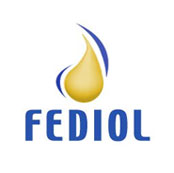Chemical refining
Chemical/alkali refining to which this notification applies consists of the following steps:
Degumming
The first step of chemical refining is degumming.
Its purpose is to remove seed particles, impurities, and most of the phosphatides, carbohydrates, proteins and traces of metals.
The crude oil is treated with foodgrade processing aids and/or water at a temperature around 100°C, which leads to hydration of most of the phosphatides, proteins, carbohydrates and traces of metals.
The hydrated material precipitates from the oil and is removed.
Neutralisation
Alkali neutralisation reduces the content of the following components: free fatty acids, oxidation products of free fatty acids, residual proteins, phosphatides, carbohydrates, traces of metals and a part of the pigments.
The oil is treated with an alkali solution (caustic soda) that reacts with the free fatty acids present and converts them into soap stock. The mixture allows then to separate the oil phase freed from fatty acid that floats on top from a layer phase of soap, alkali solution and other impurities, which is drawn off. The oil is then washed with water to remove the soap, alkali solution and other impurities, when it is ready for the decolorizing or deodorising process.
The under layer of soap and other impurities, which is drawn from the oil, it is a solid material mixed with some water. A large proportion of it is soap stock, which may be sold to soap manufacturers or it may be treated with an acid treatment (sulphuric acid) to set free the fatty acids contained in it. These are used for feed purposes but also for soap or candle manufacturing.
Winterisation
Winterization is a process whereby waxes are crystallised and removed in a filtering process to avoid clouding of the liquid fraction at cooler temperatures. Kieselguhr, normally used as a filter aid, (is a biogenic sedimentation mineral from which the organic components are removed by thermal treatment. The filter cake that remains after the filtering process consists of oil, waxes and filter aid. The filter cake can be recycled to the toaster and added to the meal (integrated crushing/refining plant) or sold as such as a feed ingredient (refining stand alone).
The term winterization was originally applied decades ago when cottonseed oil was subjected to winter temperatures to accomplish this process. Winterization processes using temperature to control crystallization are carried out on sunflower and maize oil. A similar process called dewaxing is utilized to clarify oils containing trace amounts of clouding constituents.
Bleaching
The purpose of bleaching (or decolorizing) is to reduce the levels of pigments such as carotenoids and chlorophyll, but it also further removes residues of phosphatides, soaps, traces of metals, oxidation products, and proteins. These trace components interfere further processing. They reduce the quality of the final product and are removed by adsorption with activated clay and silica.
In integrated crushing / refining plants the used bleaching earth is brought back into the meal. Bleaching earth originating from pure refining plants and / or hardening plants, which can contain nickel is excluded from recycling into the feed materials and is disposed of outside the feed sector.
If vegetable oils contain unacceptable levels of PAH's (polycyclic aromatic hydrocarbons), activated carbon is added to absorb and eliminate the PAH's. The used activated carbon is separated by filtration and disposed of in a suitable way outside of the food and feed sector.
Deodorisation
Deodorization is simply a vacuum steam distillation process that removes the relatively volatile components that give rise to undesirable flavours, colours and odours in fats and oils. This is feasible because of the great differences in volatility between these undesirable substances and the triglycerides.
The purpose of deodorisation, in case of no previous chemical refining step, is to reduce the level of free fatty acids and to remove odours, off-flavours and other volatile components such as pesticides and light polycyclic aromatic hydrocarbons by a stripping media. Careful execution of this process will also improve the stability and the colour of the oil, whilst preserving the nutritional value.
Depending on the residence time in the deodoriser, the process is carried out under vacuum (0.5 – 8 mbar) and at temperatures between 180° - 270°C, and using a stripping media, such as steam or nitrogen, since the substances responsible for odours and flavours are usually volatile. Conditions are adapted within these ranges as appropriate to ensure the removal of specific substances. Further removal of the proteins is achieved at this step.
Careful execution of these four processing steps ensures that fully refined oils possess good organoleptic and physicochemical qualities. The extent of protein removal is of critical importance to absence of allergenicities.

